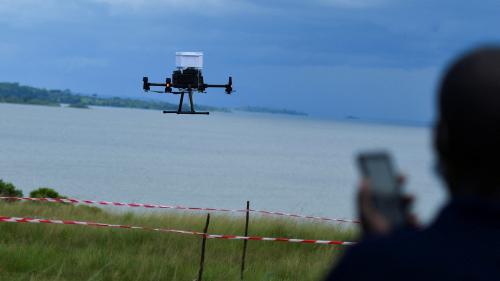Executive summary
Africa, enabled by rapid technological change and demographic shifts, is primed for a major socioeconomic and structural revolution. This report analyzes the major trends driving this change, along with the opportunities and challenges stemming from it. Africa has the fastest-growing population in the world. In fact, one in four global citizens will be African by 2050. This growing population is projected to become increasingly concentrated in urban areas as Africa continues to experience a rise in the influence of and opportunities in its major cities. This young, growing workforce will be complemented by a rapidly expanding middle class with trillions of dollars in buying power in the coming decades. This report argues that, if harnessed successfully, these trends represent a significant opportunity for African countries and the U.S. to shape a transformation on the continent that ensures prosperity and equitable growth for all.
Chapter 1 provides an overview of the major trends shaping the business environment in Africa, during and after the COVID-19 pandemic. Following financial liberalization in the 1990s, Africa has seen remarkable economic growth and reductions in poverty. However, Africa has not taken the traditional road to development. Rather, Africa’s services sector, with “industries without smokestacks,” already is exhibiting remarkably fast growth, outstripping manufacturing in its importance in driving growth on the continent. While COVID-19 has caused precipitous drops in trade and exacerbated poverty, its effects will be short term, and Africa still has tremendous growing business potential that offers rewarding opportunities to global and local businesses alike.
Chapter 2 then discusses the rise of the Fourth Industrial Revolution (4IR) in Africa, illustrating how the 4IR presents Africa with the opportunity to bridge gaps in physical and digital infrastructure, but also raises new challenges associated with stability and cybersecurity. Chapter 2 reveals that Africa is already adopting 4IR technology and explores how such technologies have the potential to increase safety and efficiency in the primary and secondary sectors of the economy and accelerate the growth of Africa’s tertiary sector. At the same time, this chapter finds that African governments do not have to limit themselves to promoting manufacturing or service sector growth; rather, mutually supporting policies capitalizing on the 4IR can be implemented to augment development in both sectors. The 4IR presents opportunities for governments to improve service delivery with new tools thanks to the rise in e-governance; however, it also presents significant risks, especially given Africa’s comparatively weak cybersecurity.
Chapter 3 illustrates how Africa is becoming increasingly interconnected, both regionally and globally. Regional free trade agreements are facilitating Africa’s efforts to transition from dependence on commodities to high-skilled, technologically intensive goods and services and manufactured goods. Also, non-Western countries have significantly increased their trade with and involvement in Africa, while China has become Africa’s largest trading partner and creditor. New partners like India and the Arab States are more aggressively engaging Africa economically. By contrast, the U.S. has taken a step back in its economic relationship with Africa, with loans, aid, trade, and foreign direct investment (FDI) inflows all falling in recent years.
Considering these trends, this report argues that it is vital that the U.S. take action to improve its position on the increasingly influential and globally immersed African continent. In particular, the U.S. should target investment and aid to areas that allow the U.S. to leverage the increasing regional trade on the continent and promote U.S.-Africa business integration. Likewise, the U.S. and other international partners should support Africa on its path to growth under the 4IR in order to ensure regional stability and mutual security. Finally, the U.S. can increase lending, using it as well for a further flex of power for mutual profit. Ultimately, this report concludes that Africa’s rise in global influence cannot be ignored. Policymakers, businesses, and international players, especially the U.S., need to take action now to ensure the coming decades result in a strategic, coordinated effort to bring about socioeconomic and structural reforms on the African continent that will benefit African, American, and global citizens alike.
Key findings
Key trends shaping Africa’s transformation and growth: This report finds that the key trends shaping Africa’s future include the continent’s rapidly growing population, increasingly young work force, more empowered consumer class, and increased urbanization. Likewise, Africa is becoming increasingly interconnected, whether it be through increased mobile phone penetration on the continent, greater access to electricity, or faster broadband speeds. The 4IR and its associated technologies also represent a key driver of transformation on the continent.
Africa has not taken a traditional path to development: Rather than following the typical development path of transitioning from agriculture to manufacturing, Africa has skipped directly to developing its tertiary sectors, especially in banking/finance, ICT services, and tourism. Likewise, Africa has urbanized at a much lower per capita income relative to other regions of the world, resulting in high inequality and poverty levels, and a larger informal sector. At the same time, Africa also is the only region whose rural population is still growing alongside its urban one.
Developing Africa’s secondary and tertiary sectors is not an either/or choice: African governments do not have to choose between promoting its manufacturing or services sectors. Rather, these sectors can be served by complementary policies, since they share a common business environment, depend on exports, and benefit from agglomeration economies. If African governments adopt policies that are targeted at these three areas, they can create synergies and promote the development of both the secondary and tertiary sectors in the process. More specifically, support for “industries without smokestacks”—sectors traditionally considered services but which share a number of characteristics with industry that make them primed for growth and job creation—can sustain Africa’s current growth trajectory.
The Fourth Industrial Revolution brings both massive opportunities and notable risks: The rise of the 4IR on the African continent presents a massive opportunity for growth and socioeconomic transformation, if managed correctly.Overall, 4IR technologies can allow Africa to bridge existing gaps in its infrastructure and leapfrog to new development stages without accumulating inefficiencies. The 4IR can increase efficiency and safety in Africa’s primary and secondary sectors, and further support the growth of “industries without smokestacks” 4IR innovations building on digitalization, including mobile money, can increase financial inclusion and formalize Africa’s massive informal sector. However, if mismanaged, the 4IR brings with it significant risks for rising inequality stemming from a shift to high-skilled labor and an increased risk of cybercrime, especially considering the Africa’s current cybersecurity weaknesses.
Regional integration can lead to more resilient economies: An increase in regional integration through free trade agreements, especially through the African Continental Free Trade Agreement (AfCFTA), can drive economic diversification and resilience to shocks, as intra-African trade features more diverse goods, including higher rates of manufactured and technologically intensive goods and services. In this way, regional integration will enable African economies to shift away from their traditional dependence on commodities, which continue to dominate its trade in international markets and leave it vulnerable to shocks.
The impacts of the COVID-19 pandemic are a temporary setback: While COVID-19 had a negative impact on the continent, Africa is already recovering and poised for a strong future. COVID-19 was accompanied by a precipitous drop in global trade and has exacerbated poverty in the region. However, prior to the pandemic, Africa had seen several decades of strong growth in per capita GDP and trade, a reduction in poverty, and an improved business environment. Increased access to finance and a fall in corruption have contributed to better business prospects. Extreme poverty is still predicted to decline, with the absolute number of citizens living in extreme poverty anticipated to fall by 27 million by 2030. Trade also is expected to rebound given increased regional integration and a fully implemented AfCFTA.
Africa has large, untapped resources: Key resources in Africa are still not being utilized to their full potential.For example, sub-Saharan Africa has the highest share of uncultivated fertile land in the world. Moreover, large areas of its land are not being utilized relative to the productive capabilities of that land, both for services and manufacturing. Likewise, Africa’s workforce also is a largely untapped resource, as gaps in education systems leave workers without the needed skills to compete in the modern economy. African farmers also face challenges related to the quality of seeds, the availability of agricultural machinery, and irrigation systems. In general, inefficiencies and gaps in existing infrastructure, whether it be education systems, electricity grids, internet access, roads, or other areas, are hindering Africa’s ability to capitalize fully on its potential.
The U.S. has fallen behind other countries in Africa and must take action now to address this issue: U.S. trade, FDI, aid, and lending with Africa all have fallen in recent years, while international players have increased their involvement and influence on the continent. In contrast, non-Western nations like China (now the region’s largest trade partner and lender), India, Japan, and the Middle East have deepened their influence in Africa. Notably, the U.S.’s decline in relations with Africa even eschews that of Western nations, since European countries like the Netherlands have increased their FDI and trade with the region, and the UK post-Brexit has also committed to increase its involvement on the continent. Considering Africa’s growing role in the global economy, the U.S. needs to take action to address its declining competitiveness on the continent both for diplomatic and economic reasons. The U.S. should strengthen ties on the continent through increased diplomatic visits, target investments based on opportunities offered by the AfCFTA, increase aid that will facilitate U.S.-Africa business partnerships while creating benefits for all stakeholders.








